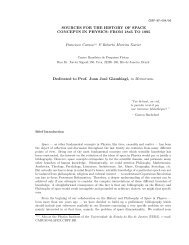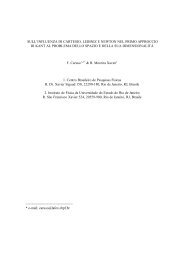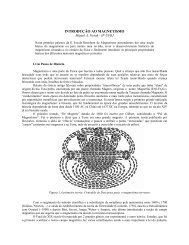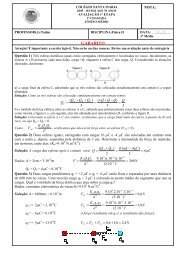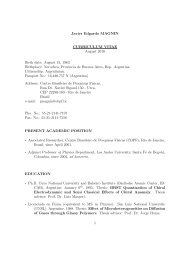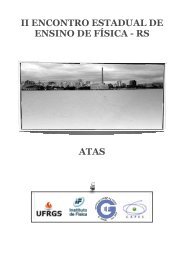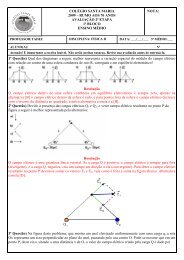Primordial non-Gaussianity in the cosmological perturbations - CBPF
Primordial non-Gaussianity in the cosmological perturbations - CBPF
Primordial non-Gaussianity in the cosmological perturbations - CBPF
You also want an ePaper? Increase the reach of your titles
YUMPU automatically turns print PDFs into web optimized ePapers that Google loves.
we learn that dur<strong>in</strong>g <strong>the</strong> de Sitter phase<br />
ρ = constant,<br />
HI = constant,<br />
where we have <strong>in</strong>dicated by HI <strong>the</strong> value of <strong>the</strong> Hubble rate dur<strong>in</strong>g <strong>in</strong>flation. Correspond<strong>in</strong>gly, we<br />
obta<strong>in</strong><br />
a = aI e HI(t−tI) , (164)<br />
where tI denotes <strong>the</strong> time at which <strong>in</strong>flation starts. Let us now see how such a period of exponential<br />
expansion takes care of <strong>the</strong> shortcom<strong>in</strong>gs of <strong>the</strong> standard Big Bang Theory. 3<br />
6.1 Inflation and <strong>the</strong> horizon Problem<br />
Dur<strong>in</strong>g <strong>the</strong> <strong>in</strong>flationary (de Sitter) epoch <strong>the</strong> horizon scale H −1<br />
I<br />
is constant. If <strong>in</strong>flation lasts long<br />
enough, all <strong>the</strong> physical scales that have left <strong>the</strong> Hubble radius dur<strong>in</strong>g <strong>the</strong> RD or MD phase can<br />
re-enter <strong>the</strong> Hubble radius <strong>in</strong> <strong>the</strong> past: this is because such scales are exponentially reduced. Indeed,<br />
while dur<strong>in</strong>g <strong>in</strong>flation <strong>the</strong> particle horizon grow exponential<br />
t<br />
RH(t) = a(t)<br />
while <strong>the</strong> Hubble radius rema<strong>in</strong>s constant<br />
tI<br />
dt ′<br />
a(t ′ ) = aI e HI(t−tI)<br />
<br />
− 1<br />
<br />
e<br />
HI<br />
−HI(t−tI) t tI<br />
a(t)<br />
, (165)<br />
HI<br />
HUBBLE RADIUS = a<br />
= H−1<br />
I , (166)<br />
˙a<br />
and po<strong>in</strong>ts that our causally disconnected today could have been <strong>in</strong> contact dur<strong>in</strong>g <strong>in</strong>flation. Notice<br />
that <strong>in</strong> comov<strong>in</strong>g coord<strong>in</strong>ates <strong>the</strong> comov<strong>in</strong>g Hubble radius shr<strong>in</strong>k exponentially<br />
COMOVING HUBBLE RADIUS = H −1<br />
I e−HI(t−tI) , (167)<br />
while comov<strong>in</strong>g length scales rema<strong>in</strong> constant. An illustration of <strong>the</strong> solution to <strong>the</strong> horizon problem<br />
can <strong>the</strong>refore be visualized as <strong>in</strong> Fig. 9. As we have seen <strong>in</strong> <strong>the</strong> previous section, this expla<strong>in</strong>s both<br />
<strong>the</strong> problem of <strong>the</strong> homogeneity of CMB and <strong>the</strong> <strong>in</strong>itial condition problem of small <strong>cosmological</strong><br />
<strong>perturbations</strong>. Once <strong>the</strong> physical length is with<strong>in</strong> <strong>the</strong> horizon, microphysics can act, <strong>the</strong> universe<br />
can be made approximately homogeneous and <strong>the</strong> primaeval <strong>in</strong>homogeneities can be created.<br />
3 Despite <strong>the</strong> fact that <strong>the</strong> growth of <strong>the</strong> scale factor is exponential and <strong>the</strong> expansion is superlum<strong>in</strong>al, this<br />
is not <strong>in</strong> contradiction with what dictated by relativity. Indeed, it is <strong>the</strong> space-time itself which is progat<strong>in</strong>g<br />
so fast and not a light signal <strong>in</strong> it.<br />
46




